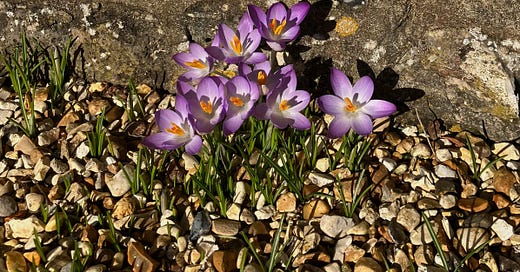Last Sunday – a day when it was almost possible to shake hands with spring – I went for a walk in the sunshine and under blue skies across to St Andrew’s church at Chilcomb, one of my favourite places to stop and sit awhile.
This close-knit group of crocuses1 was there to say good morning to.
Later in the week, I thought of the crocuses as I washed a spice pot I’d used for saffron so that I could store some peppercorns. Saffron threads (which I am lucky to have a fresh supply of from a friend in Iran) are the stigmas of a crocus flower. After I’d rinsed and dried the jar, it still smelt of saffron. Googling it, I discovered this snippet from Wikipedia (bold formatting added by me):
Direct archaeological evidence of mediaeval saffron consumption in Scandinavia comes from the wreck of the royal Danish-Norwegian flagship, Gribshunden. The ship sank in 1495 while on a diplomatic mission to Sweden. Excavations in 2021 revealed concentrations of saffron threads and small “pucks” of compressed saffron powder, along with fresh ginger, cloves, and pepper. Surprisingly, the saffron retained its distinctive odour even after more than 500 years of submersion in the Baltic Sea.2
Which does help to explain why less than five minutes of swirling the pot around in soapy water didn’t do the trick.3
In reading more about saffron (someone’s got to), I found this impressive online exhibition – the output from a recent research project by the University of Cambridge investigating evidence of saffron cultivation and use in the libraries and archives of the city, colleges, and university.
The exhibition shares snippets from ye olde recipes, as well as explaining saffron’s other uses through the ages, including that:
There are also several accounts of nuns scenting their veils with saffron as a physical and psychological pick-me-up. Katerina Lemmel (1466–1533), a Nuremberg businesswoman who became a Birgittine nun, ordered particularly large amounts from her cousin's trading firm during Lent and Advent. After all, she told him, “One does need to spice things up a bit, especially when the men and the sisters have to sing and pray so much.”
I wonder if that is where the phrase ‘spice things up a bit’ comes from?! The original (translated) quote is from a letter Katerina Lemmel wrote in 1527!4
Another of the virtual exhibition panels describes how in the seventeenth century ‘saffron featured as a face wash for the pox and a hair-dye’.5
The idea of a vibrant saffron hair dye made me think of an awesome description I read recently in Hilary Mantel’s memoir Giving Up the Ghost. It stopped me in my tracks. It’s the best description of a colour I’ve ever read.
A strange thing occurred. My mother’s hair changed colour. Once the tint of ashes, it was now a beautiful shade unknown in nature. The nearest you would come to it would be if – riding out one day in your blazoned surcoat, sword at your side, reins loose in your hands, the air mild – you observed from afar a slow fire within an autumn wood.
Isn’t it perfect? To imagine the colour, you have to think yourself into another time, another being, another story to your own. And even then, you only get close to glimpsing the exact hue. It’s an arrestingly beautiful image. It also hilariously highlights just how unnatural the shade of hair dye must be – that’s how far you have to take your imagination – timetravelling – and you still won’t get to see what Hilary sees. Given this is Mantel embodying her childhood, maybe the image is straight out of a storybook about knights (although that’s not how I interpreted it on first reading).
Anyway, at this point I’m at risk of overinterpretation of a single quote. I love it when at literary festivals/events authors get asked about the cleverness of a particular passage or image and they say, “It’s nothing as clever or hidden as that; I just wrote it that way”. So, thank you to Hilary Mantel for writing it that way.
And thanks for joining me on this Sunday crocus-inspired ramble.
Feel free to say ‘croci’ if you prefer.
Original source from this incredible research article: pmc.ncbi.nlm.nih.gov/articles/PMC9879437/
By the way, I’m still keeping up the swimming lessons and practices, and I googled how to eliminate the chloriney smell that seems to hang around (albeit in a strangely comforting way), and the internet’s advice is to ‘spritz diluted orange juice on your skin before showering’. Sounds sticky, but I’ll give it a go. If I remember to, I’ll report back.
A paper published by the Institute of Language, Cultures and Societies describes Lemmel’s letter (and others) as, “a rich source for the lived reality not just of late-medieval monasticism, but also trade, artistic patronage, finance, transport, women’s networks and more”. Which reminds me that I want to catch the Medieval Women exhibition that’s on at the British Library at the moment; I’ve heard such great things about it. Medieval literature was one of my favourite modules from my degree course, but it was very men-heavy.
Explore the online exhibition at: cam.ac.uk/stories/saffron




Might try the orange juice treatment!